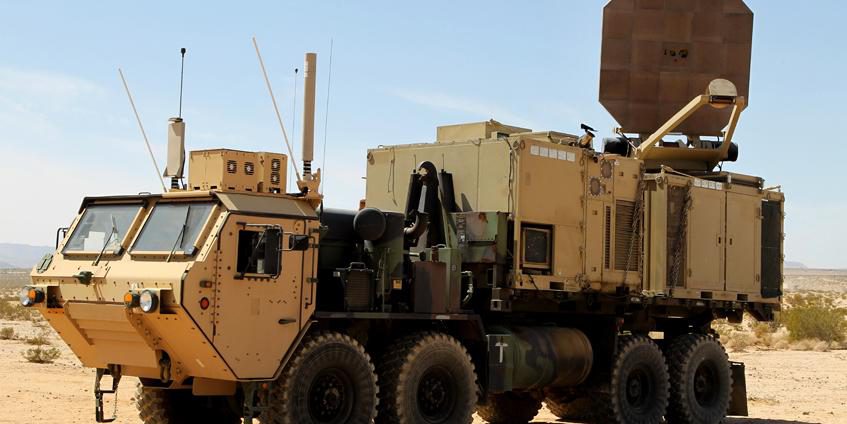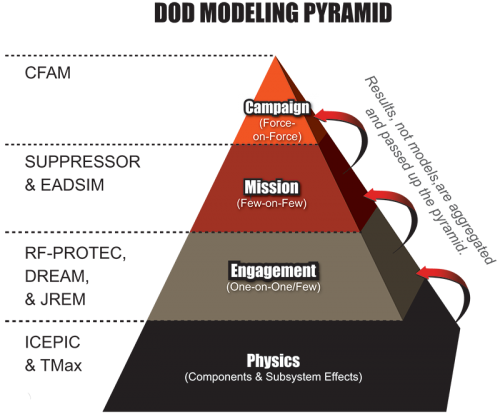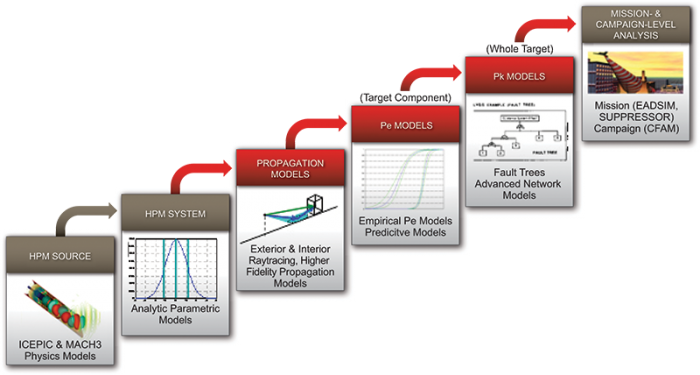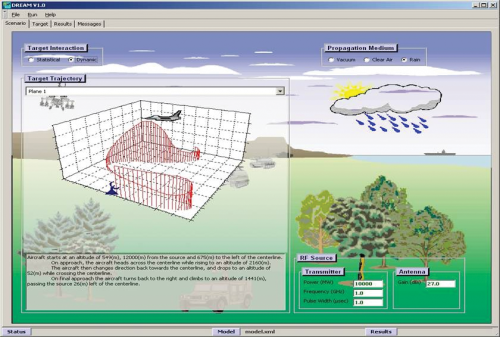INTRODUCTION
With continued advances in high-power radio frequency (HPRF)/microwave (HPM) directed energy weapon (DEW) technology, HPM DEWs are of increasing interest to the U.S. Departments of Defense (DoD) and Justice (DoJ). This increasing interest is based on numerous factors, including the ability of HPM DEWs to:
- Provide the Warfighter/law enforcer with the ability to engage a target at the speed of light and produce scalable effects from temporary to permanent, thereby reducing the possibility of collateral damage.
- Provide a relatively unlimited number of low-cost shots, constrained only by the fuel supply of the HPM DEW’s platform, which can greatly reduce the logistics tail and associated cost.
- Leverage the development of all-electric ships, aircraft, and vehicles, which can provide the necessary prime power.
Additionally, while HPM DEWs are not likely to replace traditional kinetic energy weapons (KEWs) (such as guns, projectiles, and missiles) anytime in the near future, they have the ability to greatly enhance the effectiveness of KEWs by producing functional kills (or “soft kills”) on certain targets, saving the limited KEWs for target destruction (or “hard kills”).
This article briefly introduces some of the computer-based models/ tools that are being used in the HPM DEW community to estimate the effectiveness of these types of weapons against both adversary systems (for lethality analyses) and friendly systems (for survivability analyses).
PROBLEM
The power density/fluence required on a target to produce a functional kill depends not only on the target but also on the parameters of the HPM DEW, such as power, frequency/wavelength, modulation, and engagement angle. It is extremely time-consuming and expensive to test every target over a wide range of engagement angles and HPM DEW parameters. Accordingly, there is a significant need for computer-based modeling and simulation (M&S) that can be used to estimate the incident energy/power required on the target to produce an effect for a wide range of HPM DEW parameters.
Because the energy coupling to the target is stochastic in nature (due to both random and systematic uncertainties), in reality, we must estimate a target’s probability of effect (Pe) as a function of the HPM DEW parameters, typically the incident power density/fluence on target. Further, we must ensure that the computer models are as realistic as possible. Therefore, they must undergo verification, validation, and accreditation (VV&A) to provide DoD engineers, testers, and program managers the ability to evaluate the potential effectiveness of an HPM DEW system.
HPM MODELS/TOOLS
HPM DEWs are similar in nature to a high-power radar transmitter with the exception that they can produce extremely high peak powers over tens of megawatts. An HPM DEW generates electromagnetic (EM) energy in the RF/microwave frequency range of roughly 1 to 35 GHz and uses an antenna to direct the energy to the target of interest. Because the HPM beam is typically much wider than a high-energy laser (HEL) or KEW, pointing and tracking is not as critical. Once the HPM energy hits a target, it can penetrate to the target’s electronics via both intentional ports of entry (POEs) (i.e., front doors), such as an antenna, or through unintentional POEs (i.e., backdoors), such as cracks, seams, and cables. When the EM energy enters a target system, it reradiates inside and induces currents/voltages in the pins of the electronics that are sufficient to produce either a long-term electronic upset or permanent damage. Additionally, because HPM DEWs can electronically attack a system with or without antennas and produce effects that last long after the energy is gone, DEWs represent a new form of electronic warfare (EW) known as an unconventional electronic attack (UEA).
Figure 1 illustrates a pyramid of models, with the base composed of physics and engineering models that are used to generate input to the next level of one-on-one engagement models. Because we are primarily interested in HPM DEW models that can be used to estimate the effectiveness of an HPM DEW against a selected target, these one-on-one engagement models are the models further discussed in this article.
Figure 1: HPM Modeling and Simulation Pyramid with Examples of Existing Models.
HPM DEW ENGAGEMENT MODELS
Figure 2 illustrates the critical elements in a typical one-on-one HPM DEW engagement model. The model starts with a HPM source module that generates the energy and directs it toward the target. Next is the propagation module that takes into account the spreading loss of the beam as a function of range and atmospheric losses. The propagation losses for HPM in the frequency range of 1 to 35 GHz are typically not large unless the ranges are long (roughly tens of kilometers). Therefore, the propagation modeling for HPM is typically not as critical as it is for HEL DEWs, where the energy wavelengths are much shorter and can be greatly attenuated by the weather and atmospheric conditions.
Figure 2: Modules for an End-to-End Simulation.
Next in the engagement model we have the target interaction module or target vulnerability module. This module is where the target and its interior electronics are modeled. The target interaction module includes the RF coupling to the electronics and failure level of the electronics. If the power received by a mission-critical component is greater than its failure level, we assume that the component fails and thus affects the target’s function. Finally, we compute the overall probability of target failure by combining the failure levels of each of the critical components. The output of the engagement code is typically some form of Pe of the target as a function of the HPM power density on the target and/or associated range.
The following subsections discuss some of the HPM DEW engagement models that are used to evaluate the effectiveness of an HPM DEW concept.
Directed Radio Frequency Energy Assessment Model (DREAM)
DREAM is a physics-based one-on-one engagement model developed by the U.S. Army Research Laboratory (ARL) and SPARTA Inc. in the mid 1990s. It estimates the probability of electronic upset or damage to a target system as a function of the HPM DEW’s power density on target. The relatively easy-to-use standalone model is a computer implementation of the DoD Methodology for High- Power Microwave Susceptibility Assessments developed by the Office of the Secretary of Defense’s HPM Effects panel in the 1980s. The methodology was based on the scientific method of performing pre-test analysis to predict the power densities required to produce target effects before exposing valuable electronic systems to pulses of HPM energy.
DREAM consists of two major submodules: the source module that generates the HPM pulses and directs them toward the target, and the target vulnerability module that computes the target’s probability of electronic upset or damage. A DREAM user starts by selecting either the source icon or target icon on the graphical user interface (GUI). For example, if the source icon is selected, a source input box is displayed, requesting the peak power of the HPM source, the frequency, the pulse width, and the pulse repetition rate. After completing this screen, the DREAM user selects the propagation or target icon. If the user chooses the propagation icon, the user is asked if he/she wants propagation in free space or if he/she wants to choose a weather condition, such as sunny or rain, as illustrated in Figure 3.
Figure 3: DREAM Input Screen Example.
Next, the user selects the target icon, and a target screen appears to allow the user to represent the target in terms of a failure analysis logic tree (FALT). The tree shows the relationship of the mission-critical components to the function of the target. The user then tries to identify the most likely POEs on the target for the HPM to reach the critical component. For each of the critical components, the user selects the type of POE from a menu of typical POEs, such as aperture, dipole, etc.
The user then selects the type of electronic technology used for the mission-critical component, such transistor-transistor logic (TTL), diodes, etc. Based on the frequency and the pulse width selected for the HPM source, DREAM computes the mean and standard deviation of the component failure distribution and the effective area of the POE.
DREAM then uses the POE area and the user-defined transmission loss for the entry path to compute the power received by the critical component. If the power received by the component is greater than the component’s failure level, then DREAM assumes that the component fails. Finally, DREAM computes the target’s overall Pe by combining all the failure levels of the critical components according to the target FALT.
DREAM has been distributed to several government agencies and their contractors and maintains a relatively large user community. It has been used by ARL to estimate pre-test predictions and to provide inputs to larger force-on-force models, such as the HPM Weapon Assessment Model in CASTFOREM. The Naval Air Warfare Center (NAWC) has also used DREAM to study the effectiveness of an airborne HPM weapon concepts against ship targets. To date, DREAM has been verified and validated through use, but not formally validated.
DREAM computes the Pe of a target based on the user input. Because it is a essentially an “HPM-susceptibility-level calculator,” the output (like that of any calculator) is only as accurate as the inputs used. A major weakness of DREAM is it assumes the user can identify the mission-critical component and the associated HPM paths to the component. For targets with front doors, it is a reasonable assumption that the user can identify the HPM entry paths since they are typically the same as the signal path. However, for targets with back doors, it is practically impossible to ensure that one is modeling the correct entry path. To assist users, DREAM has an Operator’s Guide that includes both a User and Analyst Guide [1]. The model is available from the U.S. Air Force Research Laboratory (AFRL).
RF Propagation and Target Effects Code (RF-PROTEC)
RF-PROTEC is a computer-based model that was developed by AFRL and ATK (now TechFlow) to estimate the effectiveness of an airborne HPM weapon against infrastructure targets (such as computer networks in a building) in terms of the probability of upsetting the network. RF-PROTEC consists of a source module, antenna module, propagation module and target interaction module, similar to DREAM. However, the model has a more sophisticated source and propagation module that uses Geometric Theory of Diffraction (GTD) to compute the electric fields/power density inside a target building and includes multiple path effects.
The target input to RF-PROTEC is experimentally derived Pe curves for each of the electronic systems in the target. The Pe curves are generated by exposing several electronic units to a fixed frequency and pulse width while increasing power density on the target to reach the upset/failure level. The fail and no-fail levels are combined to produce a Pe curve based on a logistic curve.
RF-PROTEC is an excellent model for simulating the generation and propagation of HPM energy to a target. However, the model requires several user inputs that make it less user friendly. To get an output from RF-PROTEC requires the user to have Pe curves for each of the electronic targets inside a structure. The source and propagation modules for RF-PROTEC have been verified and validated based on experimental data taken by AFRL on test buildings.
Joint RF Effectiveness Model (JREM)
JREM is a new one-on-one engagement model developed by AFRL and ARL and ATK (now TechFlow). JREM runs on a personal computer and calculates the probability of kill (Pk) of target electronics as a function of an HPM DEW power and range. The model combines the best attributes of RF-PROTEC (the source and propagation module) and DREAM (the target vulnerability module) to allow a user to get an output with or without empirically based Pe curves for each of the target’s subsystems. A JREM user can now use an empirical Pe curve if available or use the DREAM target vulnerability model to estimate a target probability of failure. JREM’s source and propagation module has been verified and validated with experiments performed by AFRL. (Note: As mentioned previously, DREAM’s vulnerability module has been verified but not formally validated.) JREM is available from AFRL [2].
HPM Lethality and Vulnerability Assessment (LAVA) Tool Kit
HPM LAVA is a new predictive modeling software tool to assess the effectiveness of HPM weapons on electronic systems of interest for blue-on-red or red-on-blue engagements. This tool is being developed for the Naval Air Warfare Center-Weapons Division (NAWC-WD) at China Lake by TechFlow and the SURVICE Engineering Company under a Phase II Small Business Innovation Research (SBIR) contract. HPM LAVA plugs into the validated JREM tool for modeling propagation of RF energy in complicated environments. It then uses a host of statistical and deterministic cavity coupling algorithms to estimate the temporal and spectral characteristics of the HPM energy coupled into complicated enclosures. Finally, it leverages TechFlow’s advancements in predictive circuit effects, garnered through several AFRL, Office of Naval Research, and Defense Threat Reduction Agency-funded programs, to model and predict the response of complicated electronics to the incident HPM stimulus. This tool captures the state-of-the-art advances in predictive HPM effects modeling backed by robust experimental data.
SUMMARY
With the ever-increasing use and development of HPM DEW technologies, the survivability/ lethality community’s interest in, and use of, HPM DEW engagement models are expected to continue to increase. As described herein, the most promising of the models in current use/development are (1) DREAM, a standalone model that can be used to estimate the probability of electronic upset or damage as a function of the HPM power density on the target and associated range; (2) JREM, the latest HPM engagement model, which contains the best features of RF-PROTEC and DREAM; and (3) HPM LAVA, a developmental model that has the potential to provide more realistic HPM coupling modeling.
(Note: The AFRL Model POCs for DREAM and JREAM are Messrs. Tim Clark and Charles Davis).
References:
- O’Connor, Robert, Karen McLaughlin, and John Tatum. “DREAM Operator’s Manual.” SPARTA Corporation and the U.S. Army Research Laboratory, 1995.
- Davis, Charles, and John Tatum. “Joint RF Effects Model Short Course.” Presented at DE Systems Symposium, National Institute of Standards and Technology, Gaithersburg, MD, April 2012.





